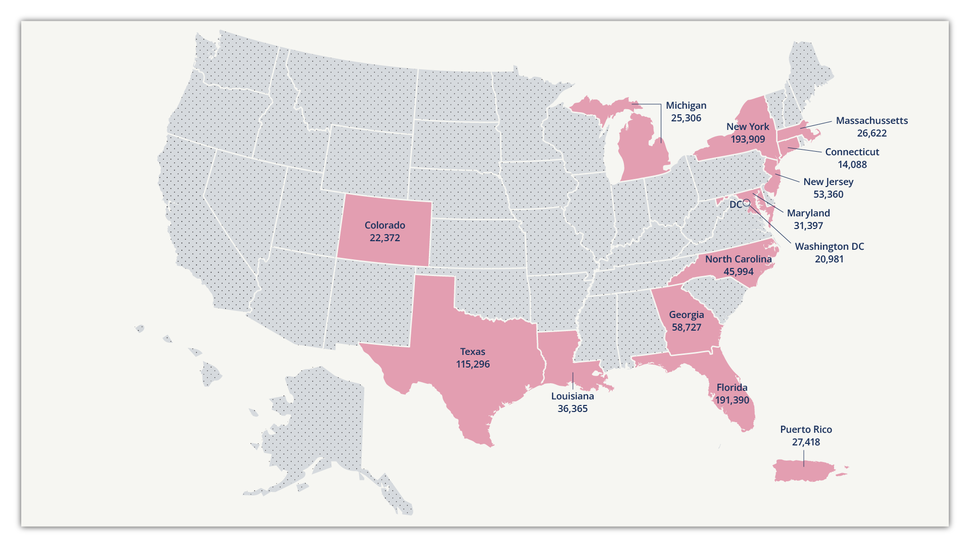Anal Cancer Risk and Survival in People with HIV
, by Elise Tookmanian, Ph.D.
Unlike other cancers, such as cervical cancer, the U.S. does not currently have national anal cancer screening guidelines. This is especially concerning for individuals with HIV, who have a much higher risk of anal cancer compared to the general U.S. population. In 2023, a series of studies using data from the HIV/AIDS Cancer Match Study were published led by postdoctoral fellows Cameron B. Haas, Ph.D., M.P.H., and Jaimie Z. Shing, Ph.D., M.P.H., under the mentorship of senior investigator Meredith Shiels, Ph.D., M.H.S., in the Infections and Immunoepidemiology Branch (IIB). The findings provide evidence to inform recommendations for anal cancer screening.
For a population to achieve the greatest benefit from screening, it is essential to identify individuals with the greatest risk of anal cancer. In the first paper, published in the Journal of the National Cancer Institute in July 2023, Dr. Haas estimated the cumulative risk of anal cancer for people with HIV stratified by HIV acquisition risk group and age at HIV or AIDS diagnosis. The 10-year cumulative risk for anal cancer was greatest for men who have sex with men diagnosed with AIDS. Among 30–34-year-olds in this group, approximately one in 240 were estimated to develop anal cancer within 10 years of their AIDS diagnosis. Additionally, for those same individuals who were cancer-free after 10 years, one in 80 are estimated to develop anal cancer in the next ten years.
The second paper, also led by Dr. Haas, investigates the rates of anal precancer from 1996–2019, which have increased since 1996, particularly for people with HIV. This increase is likely influenced by increased screening for anal cancer. Among people with HIV, those with a diagnosis of AIDS had rates of anal precancer that were nearly 3-fold higher than individuals without a diagnosis of AIDS. Those with a prior diagnosis of AIDS likely have a higher prevalence of anal precancer due to greater immunosuppression. Finally, for males and females who are diagnosed with anal precancer, approximately one in 30 were diagnosed with invasive anal cancer in 5 years following precancer diagnosis. These findings were published in the Journal of the National Cancer Institute in September 2023.
The third paper, published in The Lancet HIV in December 2023 was led by Dr. Shing. The researchers analyzed all-cause and anal-cancer specific mortality between 2001-2019, adjusting for year of cancer diagnosis, age, race and ethnicity, histology, stage, region, and treatment. When comparing anal cancer patients with HIV to patients without HIV, the researchers discovered that there was a 2.5-fold increased risk of death for female patients with HIV and a 1.4-fold increased risk of death for male anal cancer patients with HIV. This is the first study to report that anal cancer-specific mortality is significantly elevated in female patients with HIV compared to female patients without HIV. This association was masked in prior studies of anal cancer-specific mortality that combined males and females. Additionally, the researchers found that among anal cancer patients with HIV, individuals with later stage anal cancer, with anal adenocarcinoma, who inject drugs, or who were not treated for their cancer with surgery or at all had higher risk of death from all-causes and anal cancer specifically.
These studies identify priority populations that could benefit most from anal cancer screening and treatment.
References
1. Haas, CB et al. Severe anal intraepithelial neoplasia trends and subsequent invasive anal cancer in the United States. J Natl Cancer Inst 2023.
2. Haas, CB et al. Cumulative incidence of anal cancer since HIV or AIDS diagnosis in the United States. J Natl Cancer Inst 2023.
3. Shing, JZ et al. Survival by sex and HIV status in patients with anal cancer in the USA between 2001 and 2019: a retrospective cohort study. Lancet HIV 2023.
